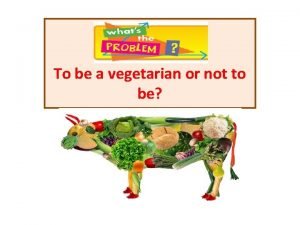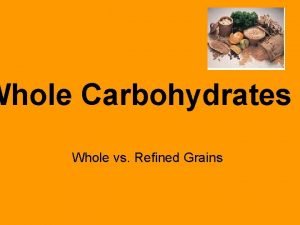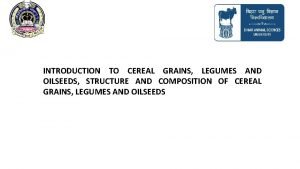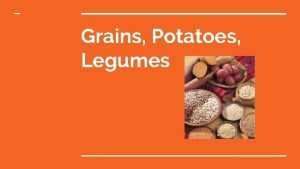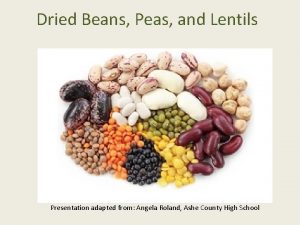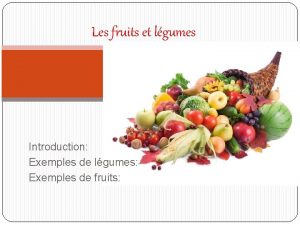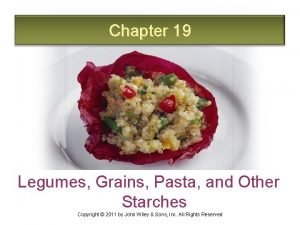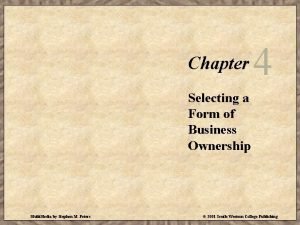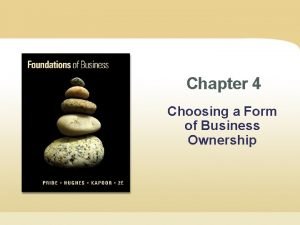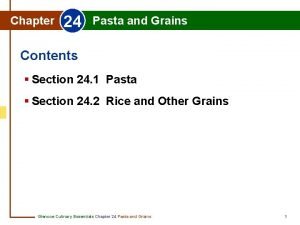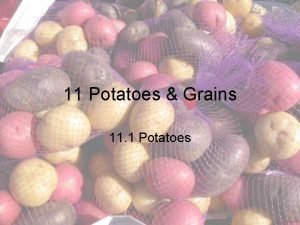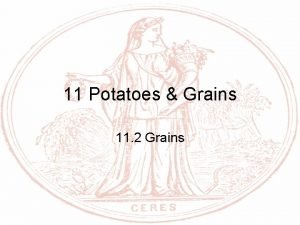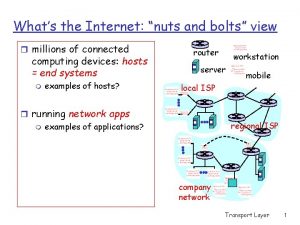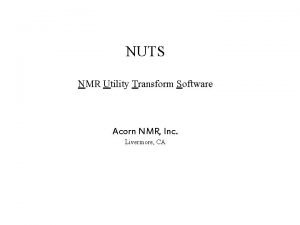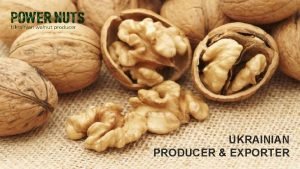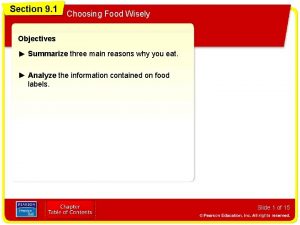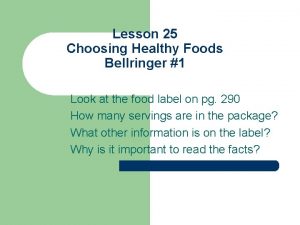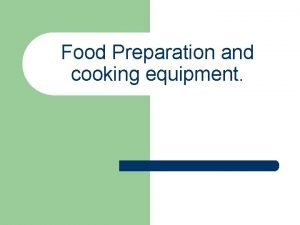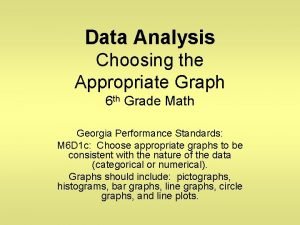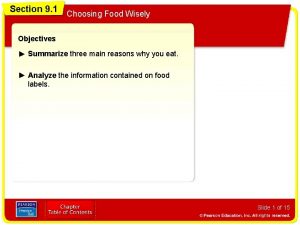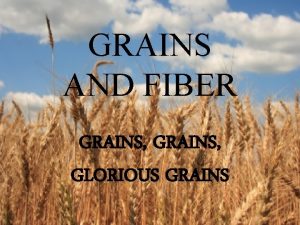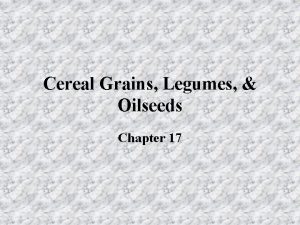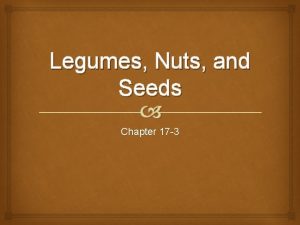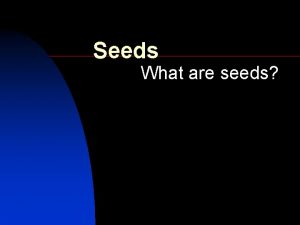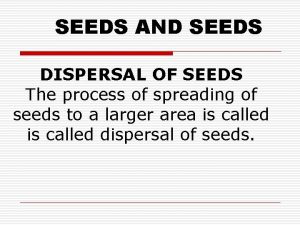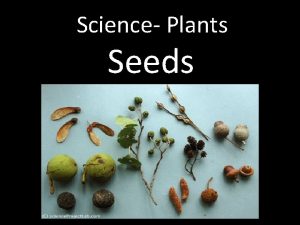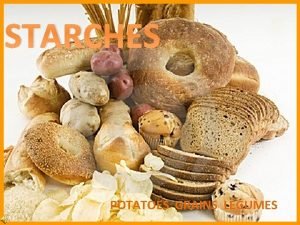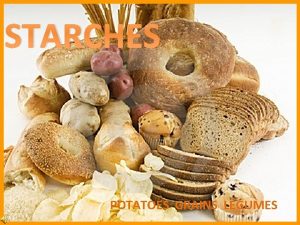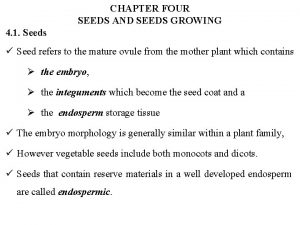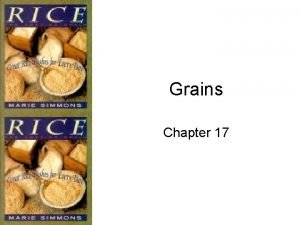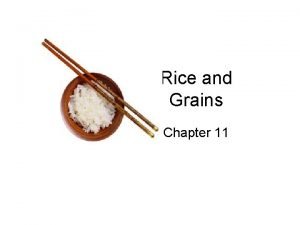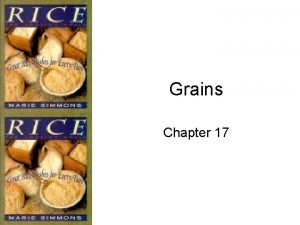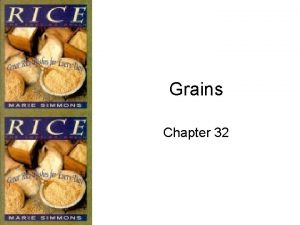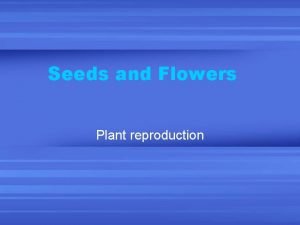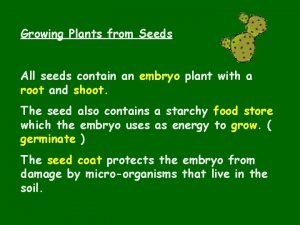Grains Legumes Nuts Seeds Chapter 30 Choosing Grains
























































- Slides: 56

Grains, Legumes, Nuts, & Seeds Chapter 30

Choosing Grains & Grain Products

What are Grains? Grains are the seeds of plants in the grass family. Grains produce many small, separate dry fruits called kernels. North American Grains Wheat Rice Corn Oats Buckwheat Rye Barley Millet Triticale (trih-tih-KAY-lee)

Why Eat Grains? They are versatile They can be included in any meal They are flavorful They are nutritious

Parts of Grains, Seeds, and Kernels Germ – the tiny embryo in a seed that will grow into a new plant Endosperm – the food supply for a seed’s embryo. Takes up most of the inner part of the grain Bran – the edible, outer protective layers of a seed

Nutrients Germ – protein, unsaturated fats, B vitamins, vitamin E, iron, zinc, minerals, and phytochemicals Endosperm – protein and starch Bran – dietary fiber, B vitamins, and minerals

Uses Served plain Used in side dishes Used to thicken soups and stews Cooked and eaten hot as cereal Cooked into desserts by adding sweeteners or fruits

Grain Processing Whole Grain – the entire edible grain kernel is used. Enrichment – a process in which some of the nutrients lost as a result of processing are added back to the product to near original levels. Fortification – a process of adding 10% or more of the daily value for a specific nutrient to a product by the manufacturer.

The Verdict Processing removes the bran, the germ, and vitamins & minerals from grains. Although some nutrients are restored through enriching and fortifying, many are lost.

Rice Short Grain – grains are almost round When cooked, rice is moist and the grains stick together. Used in dishes such as sushi or when you plan to eat with chop sticks.

Rice Medium Grain – the grains are plump, tender and moist. When cooked the grains stick together but not as much as short grain. Used in dishes such as risotto.

Rice Long Grain – when cooked, the grains are fluffy and stay separate. Most common type in North America. Used in pilafs, and side dishes.

Rice Processing Brown Rice – the whole-grain form of rice. Only inedible hull is removed. White rice – has the bran and germ removed. Converted Rice – has been parboiled (briefly boiled) to save nutrients before the hull is removed. Instant Rice – has been precooked and dehydrated.

Ready to Eat & Instant Cereals 1 Billion dollars is spent on these products annually Choose products high in complex carbohydrates and fiber Usually made from wheat, corn, or oats. When eating breakfast cereals with milk, keep in mind that vitamins and minerals are added in the form of sprays and will dissolve into the milk and be lost unless the milk is drunk after the cereal is gone.

Ready to Eat & Instant Cereals Wheat Germ – pleasant nutty flavor. Excellent source of protein, vitamins, minerals Good source of Fiber (4 g per oz) Can be added to yogurt, cereals, and other foods to boost nutrition and add crunch Oats & Grits are available in instant form Often have flavorings and sugar added.

Bread Ranges from enriched white to whole wheat and mixed whole grains They come in assorted sizes, shapes, and flavors Leavened – made with a leavening ingredient Ex. Yeast Unleavened – made without leavening agents Pita, tortilla, flat bread

Bread “Whole Wheat” mean the whole grain is used Just “wheat” usually means some part of the grain has been removed or unbleached white flour has been used Some dark breads are made with white flour and caramel color or molasses

Pasta is the Italian word for “paste” It is made from flour and water (like paste) It is rolled then shaped Ex. Spaghetti, corkscrews, bow ties, and macaroni Available in whole wheat & enriched varieties Whole wheat has 3 times the fiber Pastas can be flavored & colored Carrots, spinach, tomatoes, beets, & others

Pasta Noodles are pasta made with eggs Can be made without the yolk Lowers fat and cholesterol Dried pasta are found with shelf stable products and Fresh is found in the refrigerated section

Storing Grains & Grain Products Store Whole grains & whole-grain products in the refrigerator Whole-grain products contain oil, and can spoil at room temperature if not used quickly Refrigerate fresh pasta Store other uncooked grain and grain products (rice and dried pasta) in a cool dry place in tightly covered containers

Storing Grains & Grain Products Store breads at room temperature for short term or freeze for long term (refrigeration may cause bread to go stale faster) In humid climates or during humid weather store bread in the refrigerator to prevent it from becoming moldy. Store cooked grains in the refrigerator for a short time or in the freezer for longer

Preparing Grains & Grain Products

Principles of Cooking Grains need liquid to be prepared because they are dried Usually plain or salted water Do not rinse grains prior to cooking unless otherwise stated – results in the loss of Vitamin B Grains and Pasta tend to take the same amount of time in the microwave as they do on top of the stove

Preparing Pasta Cooked uncovered in a large pot of water Pasta must be boiled The boiling circulates the pasta for even cooking Pasta is generally cooked to a doneness known as Al Dente – firm to the bite If pasta will be cooked again (lasagna) cook for a shorter amount of time Fresh Pasta cooks in a fraction of the time

Preparing Pasta Drain pasta in a colander or strainer NEVER rinse pasta -- It removes nutrients

Cooking Pasta Boil water in a big pot Add pasta slowly so the water continues to boil Stir pasta occasionally as it cooks to prevent sticking Cook until it is al dente Drain it in a colander

Holding and Storing Pasta To keep cooked pasta hot set the colander or strainer in which the pasta was drained over a pan of hot water and cover. For freezer storage: stir in 1 teaspoon of cooking oil and freeze in serving-size portions. Pasta freezes best in sauce

Cooking Rice Bring water or another liquid to a boil Add the rice, cover, and bring to a boil again Reduce heat and simmer, stirring as little as possible Cook until rice is moist and tender There should be little to no liquid left in the pot.

Preparing Rice & Other Grains Rice is usually cooked in only the amount of liquid they can absorb Directions tell you to stir rice occasionally Do not stir long grain rice unless necessary It scrapes the starch off and cause the rice to stick together Rice, when done, should be moist, tender but firm There should be no liquid left in the pot

Preparing Rice & Other Grains Barley, grits, kasha, and other grains are cooked in much the same way as rice Bulgur is cooked by pouring boiling water over it and letting it steep for 30 minutes

Preparing Cereals Some cereals can be prepared with either water or milk Instant cereals usually only require boiling water Some ready-to-eat cereals can be microwaved and served hot Grape nuts Shredded Wheat For natural sweetness add fresh or dried fruits Strawberries, raisins, dried apricots or sliced bananas

Legumes, Nuts, and Seeds

Nutrients in Legumes are plants whose seeds grow in pods that split along both sides when ripe They are excellent sources of complex carbohydrates, protein, B vitamins, iron, calcium, potassium and some trace minerals Nearly all are low in fat Their use has been linked to a reduced risk of heart disease, some cancers, and other lifestyle diseases

Nutrients in Legumes are placed in the protein category of the Food Guide Pyramid Health experts urge eating dry beans, peas, or lentils instead of meat at least twice a week ½ cup of cooked dry beans in place of 1 oz of meat Legumes can also serve as a vegetable serving Legumes make up 2/3 of the proteins eaten by people all around the world

Legumes and Grains are incomplete proteins that do not contain all of the essential amino acids need in the diet Legumes and Grains each have the amino acids that the other one is lacking so eating them together you get a complete protein Ex. Red beans and rice Peanut butter sandwich Soybeans are the only plant based complete protein

Buying & Storing Legumes continue to dry out when stored Buy only what you will use in a 6 month period The drier they are the longer they take to cook Look for legumes that are bright in color, no visible damage, and are uniform in size Store legumes in a cool, dry place in a tightly covered container

Buying & Storing Legumes Cooked legumes can be stored in the refrigerator if you plan to use them within 3 days For longer storage freeze, add enough liquid to cover so the beans do not dry out

Types of Legumes Black Beans (turtle beans) Black skin, cream colored interior, sweet flavor Black-eyed peas Actually a bean, not pea. Small, oval, with black “eye” on one side

Types of Legumes Dry Peas Available whole or split, green or yellow Garbanzo beans (chickpeas) Round, roughly shaped, nutlike flavor, firm texture. Hold their shape when cooked

Types of Legumes Lentils Thin, tiny, disc-shaped. Come in colors ranging from grayish brown to green to reddish orange Lima Beans White, flat beans in assorted sizes. Baby limas are smallest and mild in flavor. Butter beans are largest with a rich, buttery flavor

Types of Legumes Pink and Red Beans Vary in size, flavor, and intensity of color. Kidney beans are the largest, with a hearty flavor Pinto Beans Pink and White, speckled. Similar in flavor and texture to pink and red beans

Types of Legumes Soybeans Distinct flavor. High in protein and fat, difficult to digest also known as edamame White Beans Vary in size and flavor, but all have a firm texture. Great Northern are largest. Navy beans are medium in size

Preparing Legumes Like grains they are versatile and easy to cook They tend to pick up flavors from foods they are cooked with Ex. Onion Once cooked legumes can be served whole, mashed or pureed They can be served as a side dish or a main ingredient in casseroles, soups, stews, chili, burritos, and salads

Sorting and Rinsing Before cooking sort through the legumes Discard pebbles, dirt, and stems Discard any legumes that are damaged, smaller than the others, or have a greenish tint Rinse the legumes carefully by placing them in cold water, drain, and rinse again

Soaking Beans Dry beans take one to two hours to cook Soaking before cooking can cut down on cooking time by 15 – 30 minutes Dry peas and lentils do not need to be soaked

How to Soak Beans 1. To a large pot, add about 10 cups of hot water for every pound of beans 2. Simmer for 2 to 3 minutes 3. Turn off heat 4. Cover and let soak for at least an hour

Simmering Beans Simmer beans in a large pot Seasoning may be added to increase flavor Check beans at the minimum cook time Beans that are used in salad or cooked more should be cooked less for a firmer texture If you plan to mash the beans cook a little longer When done there should be little cooking liquid left

Other Methods A convenient way to cook beans is in a slow cooker Do NOT presoak beans A pressure cooker can also be used This is faster than stove top You can microwave legumes but it takes the same amount of time as the stove top

Nuts and Seeds Included in the meat group on the Food Guide Pyramid High in protein and B vitamins They are also high in fat When eaten in moderation they can be a heart healthy food

Types of Nuts Almonds Filberts

Types of Nuts Cashews Brazil Nuts

Commonly known as Nuts Peanuts Actually a Legume Walnut Actually a seed

Seeds Sunflower Pumpkin

Seeds Squash Sesame

Buying and Storing Nuts & Seeds Both seeds and nuts are sold With or without shells Raw or roasted In oil or dry They both can be ground into a thick spreadable paste Peanut butter is the most common Avoid nuts in broken shells Store nuts and seed in refrigerator if not using them quickly because they contain oil that can go rancid

Using Nuts and Seeds Chopped or ground nuts and seeds add flavor and texture to baked goods, salads, cereal, and yogurt They can be used in meatless baked dishes to add protein Spreads can be used in sandwiches or recipes When using in low-fat cooking toast seeds and nuts to enhance flavor
 Nuts seeds legumes
Nuts seeds legumes Gymnosperm naked seed
Gymnosperm naked seed Refined breads
Refined breads O patinho que não comia legumes
O patinho que não comia legumes Structure of a cereal grain
Structure of a cereal grain Are potatoes legumes
Are potatoes legumes What are legumes
What are legumes Introduction sur les fruits et légumes
Introduction sur les fruits et légumes Legumes
Legumes Legumes
Legumes Chapter 1 choosing your career
Chapter 1 choosing your career Chapter 4 choosing a form of business ownership
Chapter 4 choosing a form of business ownership Selecting a form of business ownership
Selecting a form of business ownership Chapter 21 lesson 2 choosing to live alcohol free
Chapter 21 lesson 2 choosing to live alcohol free Chapter 20 lesson 1 the health risks of tobacco use
Chapter 20 lesson 1 the health risks of tobacco use Chapter 11 potatoes and grains
Chapter 11 potatoes and grains Chapter 24 pasta and grains answers
Chapter 24 pasta and grains answers Chapter 11 potatoes and grains
Chapter 11 potatoes and grains Ahrbore
Ahrbore Nuts and bolts of internet
Nuts and bolts of internet Three nuts for cinderella
Three nuts for cinderella Nuts and volts hunger games
Nuts and volts hunger games Petit four sec
Petit four sec Nuts nmr
Nuts nmr Ghana nuts company limited techiman
Ghana nuts company limited techiman Nuts sluts and perverts
Nuts sluts and perverts What does a smart start report look like
What does a smart start report look like Welding nuts and bolts
Welding nuts and bolts Ihss nuts and bolts
Ihss nuts and bolts Attitude countable or uncountable
Attitude countable or uncountable Nuts
Nuts Nuts and bolts business plan
Nuts and bolts business plan Leveling nuts base plates
Leveling nuts base plates Power nuts group
Power nuts group Microbiology nuts and bolts
Microbiology nuts and bolts Microbiology nuts and bolts
Microbiology nuts and bolts Two squirrels race up a tree to reach a hidden pile of nuts
Two squirrels race up a tree to reach a hidden pile of nuts Microbiology nuts and bolts
Microbiology nuts and bolts Dr david garner
Dr david garner Microbiology nuts and bolts
Microbiology nuts and bolts Choosing food wisely quiz
Choosing food wisely quiz Choosing abstinence quiz
Choosing abstinence quiz Appropriate metric unit of typical room height
Appropriate metric unit of typical room height Lesson 25 choosing healthful foods
Lesson 25 choosing healthful foods Advantages of labour saving devices in the kitchen
Advantages of labour saving devices in the kitchen Approaches to measuring performance
Approaches to measuring performance Appropriate graph
Appropriate graph Brand elements memorability example
Brand elements memorability example Defining performance and choosing a measurement approach
Defining performance and choosing a measurement approach Guided reading activity choosing the president lesson 1
Guided reading activity choosing the president lesson 1 Importance of choosing the right cooking technique
Importance of choosing the right cooking technique Unit 6 choosing the right pronoun
Unit 6 choosing the right pronoun Choose your food wisely
Choose your food wisely 17.4 choosing to be drug free
17.4 choosing to be drug free Sadlier vocab level g unit 12 synonyms and antonyms
Sadlier vocab level g unit 12 synonyms and antonyms Choosing an appropriate graph
Choosing an appropriate graph Choosing
Choosing
